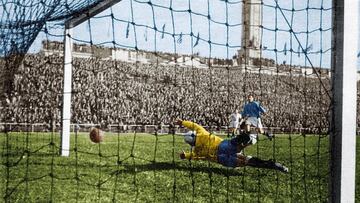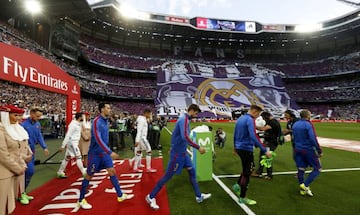The Santiago Bernabéu celebrates its 70th birthday
The home of Real Madrid hosted its first match on 14 December 1947 when Belenenses visited the Spanish capital. The stadium has witnessed history ever since.

The Estadio Santiago Bernabéu is due a round of applause. Real Madrid’s coliseum turns 70 years old today: on 14 December 1947 it was inaugurated with a match between Madrid and Belenenses, the champions of Portugal in 1946.
Nuevo Chamartín to Santiago Bernabéu
Back then, the ground was known as the Nuevo Chamartín. It assumed its current name in January 1955 as a gesture of gratitude to the president of the club and the driving force behind the project.
The two sets of directors went to mass and then ate together, as is the custom, ahead of the 15:30 kick-off on a “cold and cloudy” afternoon.
Although the stadium did not yet bear his name, a bust of Santiago Bernabéu was revealed before the match. He was the protagonist of Real Madrid’s move to the new ground with a capacity for 70,000 supporters.

He saw a dream realised upon its completion: to provide a fitting home for Los Blancos. Since then the stadium has been a Sancta Sanctorum for Madrid, and in the subsequent seven decades it has played host to collective history, legends, myths, and players who have left their mark on the way through.
Real Madrid have kept their home up to date
Bernabéu was a visionary. He realised that Real Madrid had outgrown Chamartín, their erstwhile home. And with that in mind, the club directors visited the ground adjacent to the stadium in November 1943. Works on the new stadium started in 1945, and were completed by 1947. He saw the fruit of his labour take shape: a stadium that shattered the records of the day and cost 37 million pesetas, financed by a loan from the Banco Mercantil e Industial.
Construction was led by two architects – Luis Alemany Soler and Manuel Muñoz Monasterio. They used 5,000 tonnes of cement and 1,086,000 kilograms of iron. Architecturally and in terms of structural engineering, it was a marvel. And with the passing of time it remains one of the most iconic stadiums in the world.

It has been given various facelifts since the initial construction. The second and third tiers were completed in 1954, raising the capacity to 125,000. Another ‘lick of paint’ was applied in 1982 when Spain hosted the World Cup. Seats were installed for 90,000 spectators, and a roof was added to cover three quarters of the crowd from the occasional Madrid rain. More recent changes have seen the construction of an evacuation tower in each corner, the position of the presidential balcony change, and the introduction of a heating system.
All of this has allowed Real Madrid to continue writing successful chapters in the club history.
| Classification | PTS | WM | TM | LM |
|---|
| Upcoming matches |
|---|







